语音识别训练
- 格式:doc
- 大小:207.50 KB
- 文档页数:34
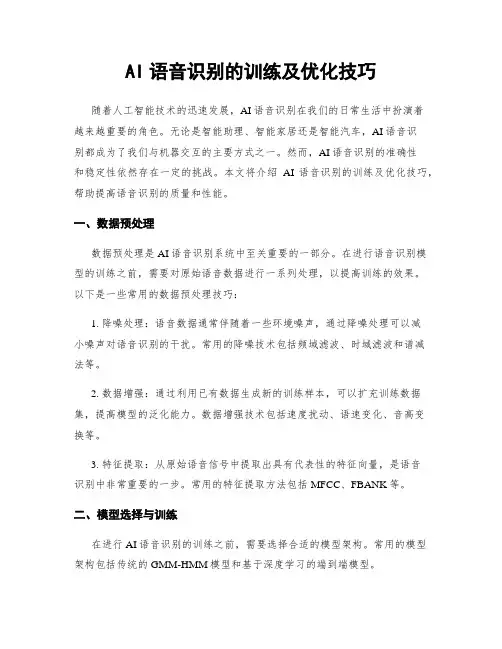
AI语音识别的训练及优化技巧随着人工智能技术的迅速发展,AI语音识别在我们的日常生活中扮演着越来越重要的角色。
无论是智能助理、智能家居还是智能汽车,AI语音识别都成为了我们与机器交互的主要方式之一。
然而,AI语音识别的准确性和稳定性依然存在一定的挑战。
本文将介绍AI语音识别的训练及优化技巧,帮助提高语音识别的质量和性能。
一、数据预处理数据预处理是AI语音识别系统中至关重要的一部分。
在进行语音识别模型的训练之前,需要对原始语音数据进行一系列处理,以提高训练的效果。
以下是一些常用的数据预处理技巧:1. 降噪处理:语音数据通常伴随着一些环境噪声,通过降噪处理可以减小噪声对语音识别的干扰。
常用的降噪技术包括频域滤波、时域滤波和谱减法等。
2. 数据增强:通过利用已有数据生成新的训练样本,可以扩充训练数据集,提高模型的泛化能力。
数据增强技术包括速度扰动、语速变化、音高变换等。
3. 特征提取:从原始语音信号中提取出具有代表性的特征向量,是语音识别中非常重要的一步。
常用的特征提取方法包括MFCC、FBANK等。
二、模型选择与训练在进行AI语音识别的训练之前,需要选择合适的模型架构。
常用的模型架构包括传统的GMM-HMM模型和基于深度学习的端到端模型。
1. GMM-HMM模型:GMM-HMM模型是传统的语音识别模型,其基本思想是将语音信号建模成由高斯混合模型(GMM)表示的状态概率分布,并使用隐马尔可夫模型(HMM)进行建模。
虽然GMM-HMM模型在早期的语音识别中取得了良好的效果,但其准确率和泛化能力相对较低。
2. 端到端模型:基于深度学习的端到端模型是当前语音识别领域的研究热点。
这种模型将输入的语音信号直接映射到输出的文本序列,不需要手工设计特征提取和建模过程。
常用的端到端模型包括基于循环神经网络(RNN)的序列到序列模型和基于Transformer的模型。
在选择了模型架构之后,需要进行模型的训练。
以下是一些模型训练的技巧:1. 数据平衡:语音识别的训练数据通常存在类别不平衡的情况,这会导致模型对少数类别的识别效果较差。
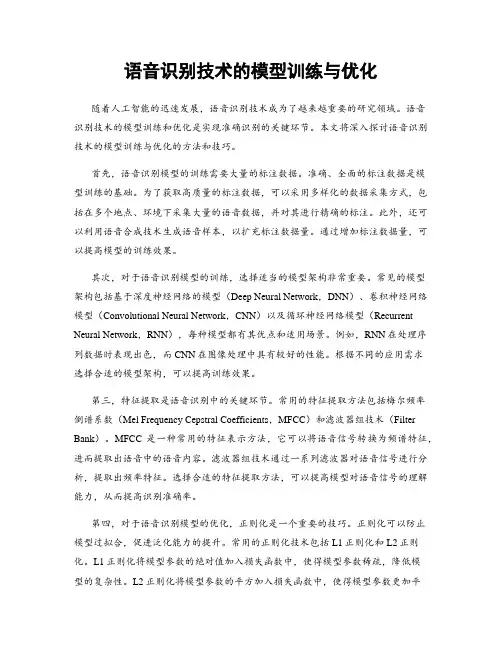
语音识别技术的模型训练与优化随着人工智能的迅速发展,语音识别技术成为了越来越重要的研究领域。
语音识别技术的模型训练和优化是实现准确识别的关键环节。
本文将深入探讨语音识别技术的模型训练与优化的方法和技巧。
首先,语音识别模型的训练需要大量的标注数据。
准确、全面的标注数据是模型训练的基础。
为了获取高质量的标注数据,可以采用多样化的数据采集方式,包括在多个地点、环境下采集大量的语音数据,并对其进行精确的标注。
此外,还可以利用语音合成技术生成语音样本,以扩充标注数据量。
通过增加标注数据量,可以提高模型的训练效果。
其次,对于语音识别模型的训练,选择适当的模型架构非常重要。
常见的模型架构包括基于深度神经网络的模型(Deep Neural Network,DNN)、卷积神经网络模型(Convolutional Neural Network,CNN)以及循环神经网络模型(Recurrent Neural Network,RNN),每种模型都有其优点和适用场景。
例如,RNN在处理序列数据时表现出色,而CNN在图像处理中具有较好的性能。
根据不同的应用需求选择合适的模型架构,可以提高训练效果。
第三,特征提取是语音识别中的关键环节。
常用的特征提取方法包括梅尔频率倒谱系数(Mel Frequency Cepstral Coefficients,MFCC)和滤波器组技术(Filter Bank)。
MFCC是一种常用的特征表示方法,它可以将语音信号转换为频谱特征,进而提取出语音中的语音内容。
滤波器组技术通过一系列滤波器对语音信号进行分析,提取出频率特征。
选择合适的特征提取方法,可以提高模型对语音信号的理解能力,从而提高识别准确率。
第四,对于语音识别模型的优化,正则化是一个重要的技巧。
正则化可以防止模型过拟合,促进泛化能力的提升。
常用的正则化技术包括L1正则化和L2正则化。
L1正则化将模型参数的绝对值加入损失函数中,使得模型参数稀疏,降低模型的复杂性。
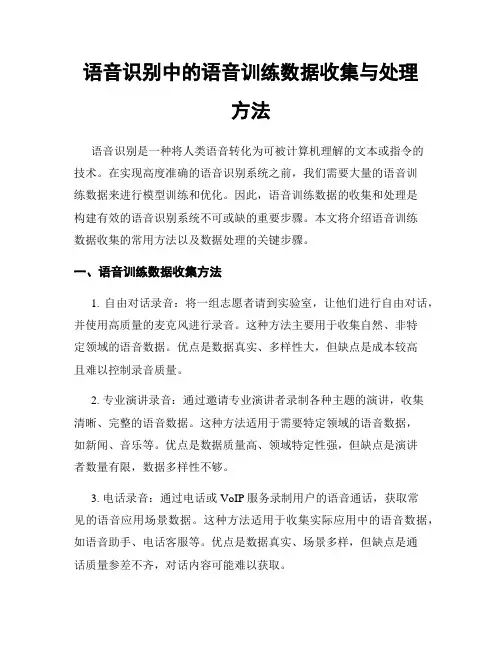
语音识别中的语音训练数据收集与处理方法语音识别是一种将人类语音转化为可被计算机理解的文本或指令的技术。
在实现高度准确的语音识别系统之前,我们需要大量的语音训练数据来进行模型训练和优化。
因此,语音训练数据的收集和处理是构建有效的语音识别系统不可或缺的重要步骤。
本文将介绍语音训练数据收集的常用方法以及数据处理的关键步骤。
一、语音训练数据收集方法1. 自由对话录音:将一组志愿者请到实验室,让他们进行自由对话,并使用高质量的麦克风进行录音。
这种方法主要用于收集自然、非特定领域的语音数据。
优点是数据真实、多样性大,但缺点是成本较高且难以控制录音质量。
2. 专业演讲录音:通过邀请专业演讲者录制各种主题的演讲,收集清晰、完整的语音数据。
这种方法适用于需要特定领域的语音数据,如新闻、音乐等。
优点是数据质量高、领域特定性强,但缺点是演讲者数量有限,数据多样性不够。
3. 电话录音:通过电话或VoIP服务录制用户的语音通话,获取常见的语音应用场景数据。
这种方法适用于收集实际应用中的语音数据,如语音助手、电话客服等。
优点是数据真实、场景多样,但缺点是通话质量参差不齐,对话内容可能难以获取。
4. 有声书籍录音:邀请专业演员朗读有声书籍,收集高质量的语音数据。
这种方法适用于收集流畅、清晰的语音数据,并且可以覆盖多个领域。
优点是录音质量高、语音流畅,但缺点是量产的有声书籍数量有限。
二、语音训练数据处理方法1. 数据清洗:语音录音后,需要进行数据清洗以去除噪音、口吃或其他不理想的录音质量。
通常使用音频处理技术如降噪、滤波来去除噪音,并通过自动语音识别技术检查录音质量。
2. 分割和标注:将录音文件分割成较小的语音片段,并为每个片段添加正确的转录文本。
这一步骤需要一些人工参与,通过手动转录或自动对齐技术来准确标注每个语音片段的文本。
3. 特征提取:从每个语音片段中提取特征,将语音信号转化为可被机器学习算法处理的数值表示。
常用的特征提取方法包括梅尔频率倒谱系数(MFCC)、线性预测系数(LPC)等。
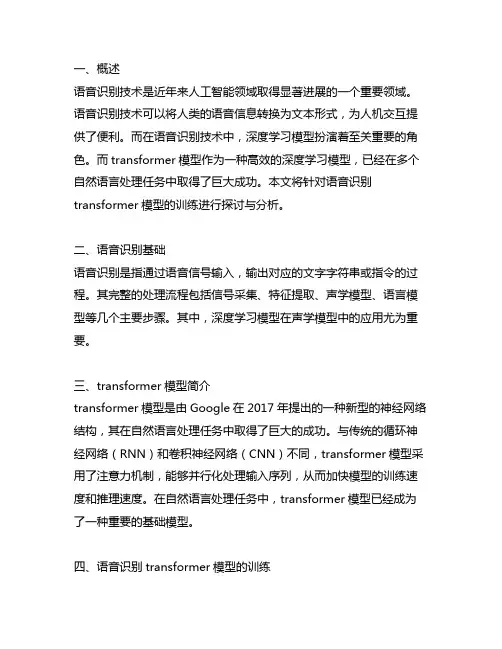
一、概述语音识别技术是近年来人工智能领域取得显著进展的一个重要领域。
语音识别技术可以将人类的语音信息转换为文本形式,为人机交互提供了便利。
而在语音识别技术中,深度学习模型扮演着至关重要的角色。
而transformer模型作为一种高效的深度学习模型,已经在多个自然语言处理任务中取得了巨大成功。
本文将针对语音识别transformer模型的训练进行探讨与分析。
二、语音识别基础语音识别是指通过语音信号输入,输出对应的文字字符串或指令的过程。
其完整的处理流程包括信号采集、特征提取、声学模型、语言模型等几个主要步骤。
其中,深度学习模型在声学模型中的应用尤为重要。
三、transformer模型简介transformer模型是由Google在2017年提出的一种新型的神经网络结构,其在自然语言处理任务中取得了巨大的成功。
与传统的循环神经网络(RNN)和卷积神经网络(CNN)不同,transformer模型采用了注意力机制,能够并行化处理输入序列,从而加快模型的训练速度和推理速度。
在自然语言处理任务中,transformer模型已经成为了一种重要的基础模型。
四、语音识别transformer模型的训练1. 数据准备语音识别transformer模型的训练首先需要大量的语音数据集。
这些数据集应该包含有丰富的语音样本,涵盖了各种语音信号的种类和场景。
还需要对这些语音数据进行预处理和特征提取,以便输入到深度学习模型中进行训练。
2. 模型构建在语音识别任务中,transformer模型通常从编码器-解码器结构中演化而来。
编码器负责处理输入语音信号,提取语音特征,而解码器则负责将这些特征映射到对应的文本输出。
在构建transformer模型时,需要考虑模型的深度、宽度和其他超参数的选择,以及注意力机制的引入等问题。
3. 模型训练在语音识别transformer模型的训练过程中,需要使用大量的训练数据,并结合合适的优化算法,如随机梯度下降(SGD)或者自适应优化算法(如Adam算法)来更新模型参数。
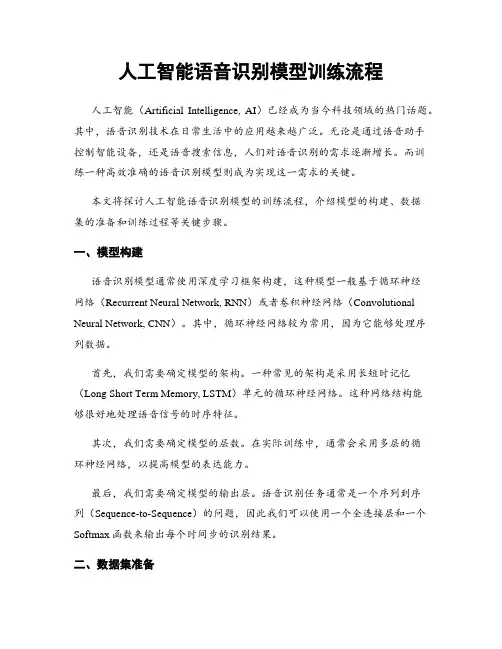
人工智能语音识别模型训练流程人工智能(Artificial Intelligence, AI)已经成为当今科技领域的热门话题。
其中,语音识别技术在日常生活中的应用越来越广泛。
无论是通过语音助手控制智能设备,还是语音搜索信息,人们对语音识别的需求逐渐增长。
而训练一种高效准确的语音识别模型则成为实现这一需求的关键。
本文将探讨人工智能语音识别模型的训练流程,介绍模型的构建、数据集的准备和训练过程等关键步骤。
一、模型构建语音识别模型通常使用深度学习框架构建,这种模型一般基于循环神经网络(Recurrent Neural Network, RNN)或者卷积神经网络(Convolutional Neural Network, CNN)。
其中,循环神经网络较为常用,因为它能够处理序列数据。
首先,我们需要确定模型的架构。
一种常见的架构是采用长短时记忆(Long Short Term Memory, LSTM)单元的循环神经网络。
这种网络结构能够很好地处理语音信号的时序特征。
其次,我们需要确定模型的层数。
在实际训练中,通常会采用多层的循环神经网络,以提高模型的表达能力。
最后,我们需要确定模型的输出层。
语音识别任务通常是一个序列到序列(Sequence-to-Sequence)的问题,因此我们可以使用一个全连接层和一个Softmax函数来输出每个时间步的识别结果。
二、数据集准备接下来,我们需要准备用于训练模型的数据集。
数据集应该包含大量的语音样本和对应的标签,用于训练模型学习语音和文字之间的映射关系。
在数据集准备过程中,首先需要收集大量的语音样本。
这些语音样本应该覆盖各种语速、发音和噪声环境等不同条件下的情况,以增加模型的鲁棒性。
接着,我们需要为每个语音样本提供对应的文本标签。
这些标签应该与语音样本的内容一一对应,以便训练时能够学习到正确的语音和文字映射关系。
最后,在数据集准备的过程中,应该进行数据的预处理和特征提取。
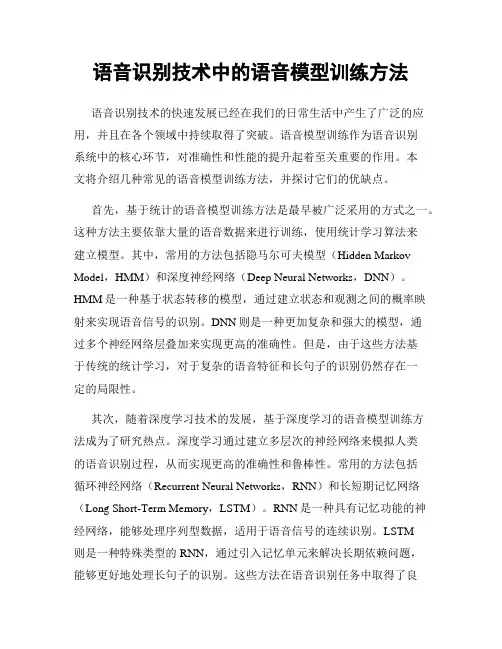
语音识别技术中的语音模型训练方法语音识别技术的快速发展已经在我们的日常生活中产生了广泛的应用,并且在各个领域中持续取得了突破。
语音模型训练作为语音识别系统中的核心环节,对准确性和性能的提升起着至关重要的作用。
本文将介绍几种常见的语音模型训练方法,并探讨它们的优缺点。
首先,基于统计的语音模型训练方法是最早被广泛采用的方式之一。
这种方法主要依靠大量的语音数据来进行训练,使用统计学习算法来建立模型。
其中,常用的方法包括隐马尔可夫模型(Hidden Markov Model,HMM)和深度神经网络(Deep Neural Networks,DNN)。
HMM是一种基于状态转移的模型,通过建立状态和观测之间的概率映射来实现语音信号的识别。
DNN则是一种更加复杂和强大的模型,通过多个神经网络层叠加来实现更高的准确性。
但是,由于这些方法基于传统的统计学习,对于复杂的语音特征和长句子的识别仍然存在一定的局限性。
其次,随着深度学习技术的发展,基于深度学习的语音模型训练方法成为了研究热点。
深度学习通过建立多层次的神经网络来模拟人类的语音识别过程,从而实现更高的准确性和鲁棒性。
常用的方法包括循环神经网络(Recurrent Neural Networks,RNN)和长短期记忆网络(Long Short-Term Memory,LSTM)。
RNN是一种具有记忆功能的神经网络,能够处理序列型数据,适用于语音信号的连续识别。
LSTM则是一种特殊类型的RNN,通过引入记忆单元来解决长期依赖问题,能够更好地处理长句子的识别。
这些方法在语音识别任务中取得了良好的效果,但是它们的模型复杂度较高,需要大量的计算资源和数据进行训练。
此外,迁移学习技术在语音模型训练中也得到了广泛应用。
迁移学习通过将在其他相关任务上已经训练好的模型参数迁移到目标任务上,加快模型训练过程和提高模型的准确性。
在语音识别领域,常用的迁移学习方法包括迁移自微调(Fine-tuning)和迁移自预训练(Pre-training)。
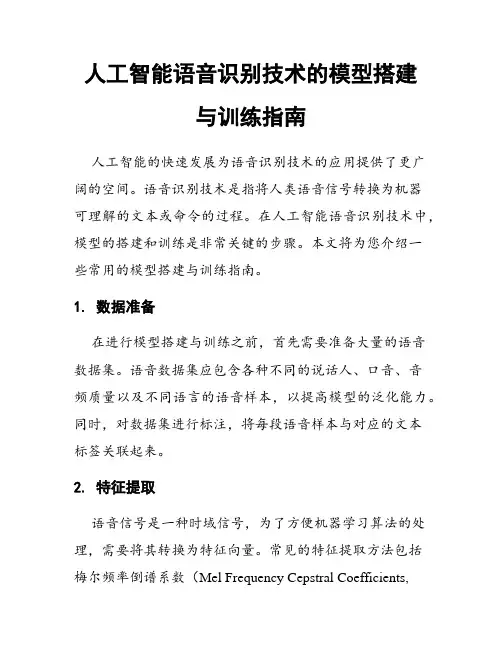
人工智能语音识别技术的模型搭建与训练指南人工智能的快速发展为语音识别技术的应用提供了更广阔的空间。
语音识别技术是指将人类语音信号转换为机器可理解的文本或命令的过程。
在人工智能语音识别技术中,模型的搭建和训练是非常关键的步骤。
本文将为您介绍一些常用的模型搭建与训练指南。
1. 数据准备在进行模型搭建与训练之前,首先需要准备大量的语音数据集。
语音数据集应包含各种不同的说话人、口音、音频质量以及不同语言的语音样本,以提高模型的泛化能力。
同时,对数据集进行标注,将每段语音样本与对应的文本标签关联起来。
2. 特征提取语音信号是一种时域信号,为了方便机器学习算法的处理,需要将其转换为特征向量。
常见的特征提取方法包括梅尔频率倒谱系数(Mel Frequency Cepstral Coefficients,MFCC)和滤波器组组合(Filter-Bank Energies, FBE)。
这些特征向量能够捕捉语音中的语音内容和语音特征,为模型训练提供了输入数据。
3. 模型选择在模型选择方面,目前常用的深度学习模型包括卷积神经网络(Convolutional Neural Network, CNN)、长短时记忆网络(Long Short-Term Memory, LSTM)和端到端模型(End-to-End Model)。
卷积神经网络适用于提取语音信号的局部特征,长短时记忆网络则能够很好地建模语音的时序关系。
而端到端模型则可以直接将语音信号输入模型,无需人工提取特征。
4. 模型搭建根据选择的模型,可以使用相应的深度学习框架来搭建模型。
常用的深度学习框架包括TensorFlow、PyTorch和Keras等。
在搭建模型的过程中,需要将数据集进行划分为训练集、验证集和测试集,用于模型的训练和评估。
同时,选择适当的损失函数和优化器来优化模型参数。
5. 模型训练在进行模型训练之前,可以对数据集进行预处理的步骤,例如数据增强和数据标准化,以增加模型的鲁棒性和泛化能力。
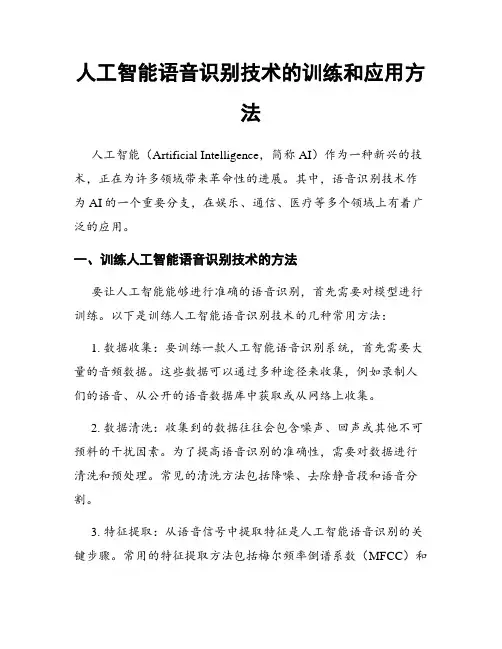
人工智能语音识别技术的训练和应用方法人工智能(Artificial Intelligence,简称AI)作为一种新兴的技术,正在为许多领域带来革命性的进展。
其中,语音识别技术作为AI的一个重要分支,在娱乐、通信、医疗等多个领域上有着广泛的应用。
一、训练人工智能语音识别技术的方法要让人工智能能够进行准确的语音识别,首先需要对模型进行训练。
以下是训练人工智能语音识别技术的几种常用方法:1. 数据收集:要训练一款人工智能语音识别系统,首先需要大量的音频数据。
这些数据可以通过多种途径来收集,例如录制人们的语音、从公开的语音数据库中获取或从网络上收集。
2. 数据清洗:收集到的数据往往会包含噪声、回声或其他不可预料的干扰因素。
为了提高语音识别的准确性,需要对数据进行清洗和预处理。
常见的清洗方法包括降噪、去除静音段和语音分割。
3. 特征提取:从语音信号中提取特征是人工智能语音识别的关键步骤。
常用的特征提取方法包括梅尔频率倒谱系数(MFCC)和线性预测编码(LPC)。
这些特征提取方法可以将语音信号转化为可用于训练模型的数字向量。
4. 模型选择与训练:训练人工智能语音识别模型有多种选择,包括隐马尔可夫模型(HMM)、循环神经网络(RNN)和卷积神经网络(CNN)。
选择适合任务需求的模型并对其进行训练是确保准确识别的关键。
5. 参数调优:训练完成后,需要对模型进行调优。
参数调优可以通过交叉验证、正则化和优化算法等方法来进行,以进一步提高模型的准确性和稳定性。
二、人工智能语音识别技术的应用方法经过训练,人工智能语音识别技术可以应用于许多领域。
下面是该技术的几种常见应用方法:1. 语音助手:现如今,智能手机和智能音箱等设备已经普及,人们可以通过语音与这些设备进行交互。
人工智能语音识别技术可以让这些语音助手准确地理解人们的指令,例如语音搜索、设置提醒或进行在线购物。
2. 电话客服:在客服行业中,人工智能语音识别技术可以用于电话客服自动化。
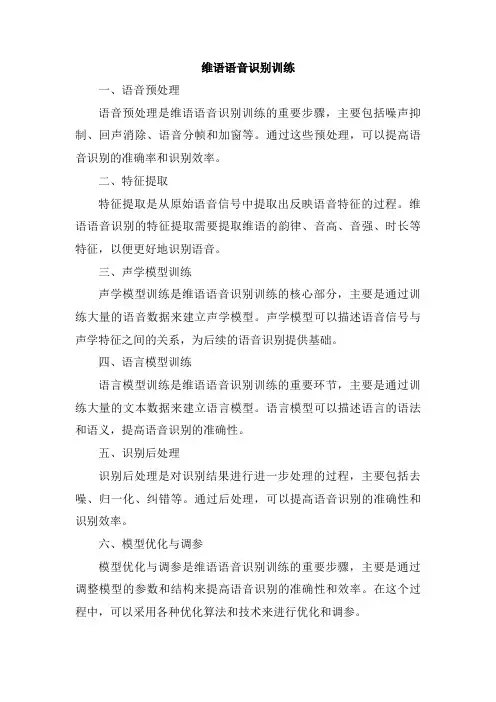
维语语音识别训练一、语音预处理语音预处理是维语语音识别训练的重要步骤,主要包括噪声抑制、回声消除、语音分帧和加窗等。
通过这些预处理,可以提高语音识别的准确率和识别效率。
二、特征提取特征提取是从原始语音信号中提取出反映语音特征的过程。
维语语音识别的特征提取需要提取维语的韵律、音高、音强、时长等特征,以便更好地识别语音。
三、声学模型训练声学模型训练是维语语音识别训练的核心部分,主要是通过训练大量的语音数据来建立声学模型。
声学模型可以描述语音信号与声学特征之间的关系,为后续的语音识别提供基础。
四、语言模型训练语言模型训练是维语语音识别训练的重要环节,主要是通过训练大量的文本数据来建立语言模型。
语言模型可以描述语言的语法和语义,提高语音识别的准确性。
五、识别后处理识别后处理是对识别结果进行进一步处理的过程,主要包括去噪、归一化、纠错等。
通过后处理,可以提高语音识别的准确性和识别效率。
六、模型优化与调参模型优化与调参是维语语音识别训练的重要步骤,主要是通过调整模型的参数和结构来提高语音识别的准确性和效率。
在这个过程中,可以采用各种优化算法和技术来进行优化和调参。
七、持续学习与更新随着维语语音数据的不断增加和语言的变化,需要不断更新和优化维语语音识别系统。
因此,需要采用持续学习与更新的技术来不断优化模型的性能,提高语音识别的准确性和效率。
八、评估与测试评估与测试是维语语音识别训练的重要环节,主要是通过测试集对模型的性能进行评估和测试。
评估指标主要包括准确率、召回率、F1值等。
同时,还需要对模型的鲁棒性、稳定性等方面进行测试和评估,以确保模型的性能和稳定性。
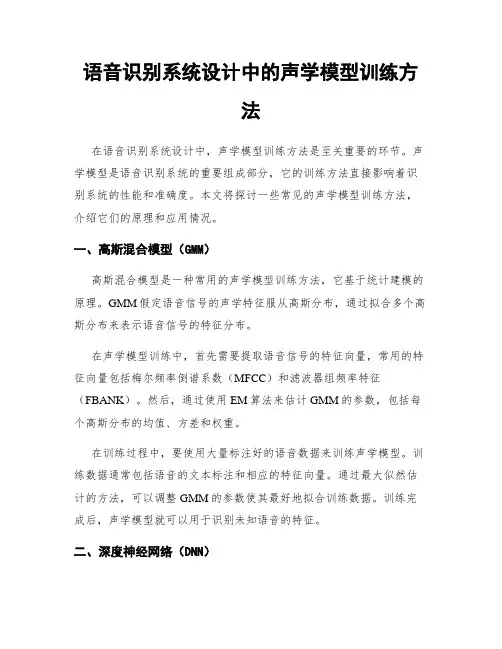
语音识别系统设计中的声学模型训练方法在语音识别系统设计中,声学模型训练方法是至关重要的环节。
声学模型是语音识别系统的重要组成部分,它的训练方法直接影响着识别系统的性能和准确度。
本文将探讨一些常见的声学模型训练方法,介绍它们的原理和应用情况。
一、高斯混合模型(GMM)高斯混合模型是一种常用的声学模型训练方法,它基于统计建模的原理。
GMM假定语音信号的声学特征服从高斯分布,通过拟合多个高斯分布来表示语音信号的特征分布。
在声学模型训练中,首先需要提取语音信号的特征向量,常用的特征向量包括梅尔频率倒谱系数(MFCC)和滤波器组频率特征(FBANK)。
然后,通过使用EM算法来估计GMM的参数,包括每个高斯分布的均值、方差和权重。
在训练过程中,要使用大量标注好的语音数据来训练声学模型。
训练数据通常包括语音的文本标注和相应的特征向量。
通过最大似然估计的方法,可以调整GMM的参数使其最好地拟合训练数据。
训练完成后,声学模型就可以用于识别未知语音的特征。
二、深度神经网络(DNN)深度神经网络是近年来发展起来的一种强大的声学模型训练方法。
DNN是一种多层感知器模型,通过多层神经元的组合和非线性变换来对语音信号进行建模。
与GMM相比,DNN能够学习到更复杂的语音特征表示,从而提高识别准确率。
DNN的训练过程是通过反向传播算法来进行的,首先通过随机初始化权重和偏置,然后逐渐调整它们使得DNN的输出与标注的语音标签最匹配。
与GMM相比,DNN需要更大规模的训练数据来获得更好的性能。
此外,为了避免过拟合现象,还需要进行正则化和提前停止等技术手段。
三、循环神经网络(RNN)循环神经网络是一种特殊类型的神经网络,常用于处理序列数据,如语音和文本。
RNN的一个重要特点是它可以通过时间步骤之间的信息传递来处理动态序列数据。
在语音识别中,RNN常常被用来对声学特征进行建模。
RNN的训练过程类似于DNN,通过反向传播来调整权重和偏置。
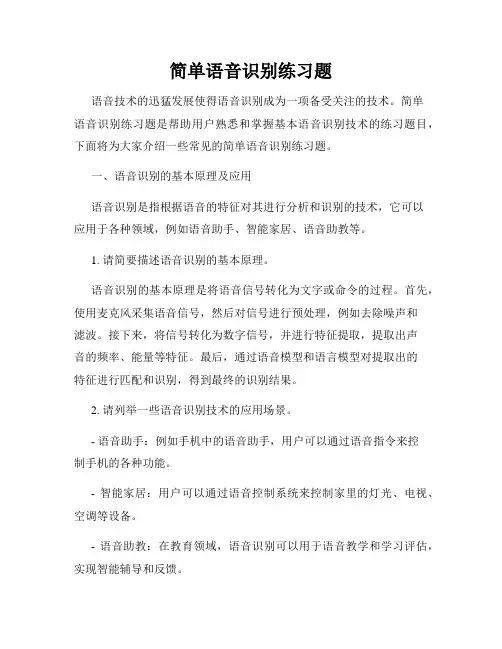
简单语音识别练习题语音技术的迅猛发展使得语音识别成为一项备受关注的技术。
简单语音识别练习题是帮助用户熟悉和掌握基本语音识别技术的练习题目,下面将为大家介绍一些常见的简单语音识别练习题。
一、语音识别的基本原理及应用语音识别是指根据语音的特征对其进行分析和识别的技术,它可以应用于各种领域,例如语音助手、智能家居、语音助教等。
1. 请简要描述语音识别的基本原理。
语音识别的基本原理是将语音信号转化为文字或命令的过程。
首先,使用麦克风采集语音信号,然后对信号进行预处理,例如去除噪声和滤波。
接下来,将信号转化为数字信号,并进行特征提取,提取出声音的频率、能量等特征。
最后,通过语音模型和语言模型对提取出的特征进行匹配和识别,得到最终的识别结果。
2. 请列举一些语音识别技术的应用场景。
- 语音助手:例如手机中的语音助手,用户可以通过语音指令来控制手机的各种功能。
- 智能家居:用户可以通过语音控制系统来控制家里的灯光、电视、空调等设备。
- 语音助教:在教育领域,语音识别可以用于语音教学和学习评估,实现智能辅导和反馈。
二、语音识别的技术和算法语音识别的技术和算法涉及到信号处理、模型建立和模型训练等方面。
1. 请简要介绍一些常用的语音识别技术和算法。
- MFCC(梅尔倒谱系数):MFCC是一种常用的语音特征提取方法,它模拟了人耳的感知特性,可以提取出声音的特征。
- HMM(隐马尔可夫模型):HMM是一种常用的语音识别模型,它可以建立声音和语言之间的映射关系。
- DNN(深度神经网络):DNN是一种深度学习模型,可以用于提取语音信号的高级特征,提高语音识别的精度。
2. 请简要描述语音识别中的声学模型和语言模型。
- 声学模型:声学模型用于将语音信号的特征与声音单位(音素或子词)建立映射关系。
常见的声学模型包括GMM-HMM模型和DNN 模型。
- 语言模型:语言模型用于根据语法和语言知识对识别结果进行调整和优化,提高识别的准确性。
计算机言语疾病矫治训练范围一、语音识别训练语音识别技术是计算机科学和人工智能领域的一个重要分支,其目标是将人类语音转换成文本。
在计算机言语疾病矫治训练中,语音识别训练旨在提高计算机对语音信号的识别能力,以便更准确地理解患者的言语表达。
二、语音合成训练语音合成技术是利用计算机生成人类语音的技术。
在计算机言语疾病矫治训练中,语音合成训练可以生成自然、流畅的语音,帮助患者进行发音练习和语言康复。
三、语音评估训练语音评估技术是对人类语音质量进行评估和诊断的一种技术。
在计算机言语疾病矫治训练中,语音评估训练可用于评估患者的发音状况,识别语音病理学特征,为患者提供个性化的矫治方案。
四、语音情感分析训练语音情感分析技术是通过分析人类语音中的情感表达来识别其情绪状态。
在计算机言语疾病矫治训练中,语音情感分析训练可以帮助患者了解自己的情绪状态,促进情感表达和情绪调节能力的提高。
五、语音病理学训练语音病理学是研究人类语音障碍的学科。
在计算机言语疾病矫治训练中,语音病理学训练提供了对各种语音障碍的理解和治疗方法,帮助患者纠正发音问题,提高语音质量。
六、语音信号处理训练语音信号处理是对人类语音信号进行分析、处理和变换的技术。
在计算机言语疾病矫治训练中,语音信号处理训练可以提取语音特征,进行音调和音色调整,优化语音输出效果。
七、语音编码训练语音编码是将人类语音转换成数字信号的过程。
在计算机言语疾病矫治训练中,语音编码训练可以提高计算机对不同语言和方言的适应性,确保准确识别和理解患者的言语表达。
八、语音转录训练语音转录是将人类语音转换成文本的过程。
在计算机言语疾病矫治训练中,语音转录训练可以帮助患者更方便地与计算机进行交互,提高沟通效率。
九、语音唤醒训练语音唤醒是指通过计算机识别特定关键词或短语来触发特定响应或操作的技术。
在计算机言语疾病矫治训练中,语音唤醒训练可以帮助患者利用语音来操作计算机,提高操作效率和便利性。
十、语音控制训练语音控制是指通过计算机识别和理解人类语音来控制机械设备的技术。
语音识别系统的深度学习模型训练指南随着人工智能技术的快速发展,语音识别系统在各个领域中得到了广泛应用。
为了提高语音识别的准确性和稳定性,深度学习模型逐渐成为了训练语音识别系统的首选方法。
本文将介绍语音识别系统的深度学习模型训练指南,帮助读者了解如何使用深度学习模型训练一个高效准确的语音识别系统。
一、数据准备语音识别系统的训练离不开大量的标注数据。
为了训练一个准确的深度学习模型,我们需要收集和整理一组带有正确标注的语音数据集。
在选择数据集时,需要确保数据集的多样性和覆盖面,以便模型可以适应不同的语音输入。
同时,在数据准备阶段,我们需要对原始语音数据进行预处理。
预处理包括去噪、音频格式转换、音频分段等操作,以便提高语音识别系统的鲁棒性和准确性。
二、模型选择在深度学习模型中,循环神经网络(RNN)和卷积神经网络(CNN)是常用的模型类型。
对于语音识别系统,循环神经网络在建模时序信息方面具有优势,而卷积神经网络在提取局部特征方面表现出色。
因此,可以使用RNN 和CNN的结合体,即混合模型,来训练语音识别系统。
三、模型架构设计语音识别系统的深度学习模型架构设计是训练过程中的关键一步。
在设计过程中,需要考虑以下几个因素:1. 输入层:根据语音信号的特点,将其转换为适合模型输入的特征表示。
常见的特征表示方法包括梅尔频率倒谱系数(MFCC)和滤波器组谱系数(FBANK)。
2. 中间层:可以使用多个循环神经网络层和卷积神经网络层来提取特征和建模时序信息。
其中,循环神经网络层可以使用长短时记忆网络(LSTM)或门控循环单元(GRU)等结构。
3. 输出层:根据具体任务要求,确定输出层的神经元个数和激活函数。
对于语音识别系统,可以使用软最大值函数或sigmoid函数等来实现多类别的分类问题。
四、模型训练模型训练是深度学习模型训练指南的核心内容。
以下是模型训练的一般流程:1. 初始化参数:初始化模型的权重和偏置。
2. 前向传播:将输入数据传递给模型,并计算模型的预测结果。
语音识别技术中的声学模型训练方法在语音识别技术中,声学模型是其中关键的一部分,它用来对音频信号进行分析和处理,从而实现将语音转换成文本的功能。
声学模型训练方法是确定声学模型参数的过程,旨在提高识别准确度和性能。
本文将介绍一些常见的声学模型训练方法,包括高斯混合模型(GMM)、隐马尔可夫模型(HMM)、深度神经网络(DNN)等。
首先,高斯混合模型(GMM)是一种经典的声学模型训练方法。
它假设语音信号由多个高斯分布组合而成,每个高斯分布对应一个语音单位。
GMM模型的训练过程包括两个主要步骤:参数初始化和迭代训练。
参数初始化时,通过使用一定数量的高斯分布对观测数据进行建模。
然后,利用EM(期望最大化)算法依次对每个高斯分布的参数进行优化。
迭代训练过程会不断更新模型的参数,直到达到收敛条件。
GMM的优点在于理论基础扎实,易于实现,但其准确度相对较低,对于复杂的语音信号建模较为有限。
其次,隐马尔可夫模型(HMM)是语音识别中广泛应用的一种声学模型训练方法。
HMM模型假设语音信号是通过一个隐藏的马尔可夫过程生成的,其中隐藏状态对应于语音的音素单位。
在HMM模型的训练过程中,需要定义初始模型和状态转移概率矩阵,同时利用一组标注好的语音数据进行参数优化。
常用的HMM训练算法包括Baum-Welch算法和Viterbi算法。
Baum-Welch算法通过迭代优化模型参数,以达到最大似然估计;而Viterbi算法则用于解码过程,实现将音频信号转换为文本的功能。
HMM模型的优点在于它能够有效地捕捉到语音信号的时序特性,减少了模型复杂度,提高了识别准确度。
最后,随着深度学习的兴起,深度神经网络(DNN)在语音识别领域引入了新的思路。
DNN模型通过多层神经元的叠加来对声学特征进行建模,可以提取出更高阶的特征表示。
DNN的训练过程主要包括两个步骤:前向传播和反向传播。
前向传播过程是信号从输入层经过各隐藏层到输出层的传递过程,反向传播则是根据预测结果和真实标签之间的差异来调整模型参数,从而优化模型。
语音识别中的语音模型训练与参数调优语音识别是一种将语音信号转换为文本的技术,它在许多领域中被广泛应用,如语音助理、电话自动化系统和语音指令识别等。
语音识别系统的核心组件之一是语音模型,它是训练出来的用于识别语音的模型。
语音模型训练是一个复杂而关键的过程,需要通过大量的语音数据来训练模型。
语音数据可以是人工录制的语音,也可以是从语音库中获取的现成录音。
在训练语音模型之前,首先需要对原始语音数据进行预处理,包括音频格式转换、降噪和音频分割等步骤。
然后,将处理后的数据划分为训练集、验证集和测试集。
在语音模型的训练过程中,最为重要的是选择合适的模型架构和参数。
常用的语音模型架构包括隐马尔可夫模型(HMM)、循环神经网络(RNN)和卷积神经网络(CNN)等。
不同的架构适用于不同的应用场景,选择合适的架构对模型的准确性和性能至关重要。
参数调优是进一步提高语音模型性能的关键步骤。
参数调优可以包括学习率的选择、权重的初始化、正则化技术的应用等。
学习率的选择直接影响了模型的收敛速度和性能,通常可以通过交叉验证来确定最佳的学习率。
权重的初始化是训练模型时的一项重要任务,良好的初始化可以加速收敛并提高模型的准确性。
正则化技术可以帮助减少模型的过拟合,提高模型的泛化能力。
在实际应用中,语音模型的训练和参数调优往往需要耗费大量的时间和计算资源。
为了加快训练过程,可以使用分布式训练技术,将训练任务分配给多个计算节点来并行处理。
此外,还可以利用计算加速硬件如GPU或TPU等来加快训练速度。
同时,还可以使用现成的预训练模型来初始化模型参数,以加速模型的收敛和提高训练效果。
除了模型训练和参数调优,还有一些其他的技术可以进一步提升语音识别系统的性能。
例如,语音数据增强技术可以通过合成新的训练数据来丰富训练集,改善模型的泛化能力。
同时,注意力机制和集成学习等方法也可以用于提升语音识别的准确性和稳定性。
总结起来,语音识别中的语音模型训练与参数调优是构建高效且准确的语音识别系统的关键步骤。
语音识别中声学模型训练的技巧与调优策略语音识别(Automatic Speech Recognition, ASR)是一种将语音信号转换为可被计算机理解的文本或命令的技术。
在语音识别系统中,声学模型(Acoustic Model)被用于对输入语音信号进行建模和识别。
声学模型的训练是提高语音识别系统准确性的关键步骤之一。
本文将介绍在语音识别中声学模型训练的技巧与调优策略,以帮助读者更好地理解和应用这一技术。
首先,声学模型的训练数据的质量对训练效果有着重要影响。
训练数据应尽可能地多样化和丰富,以覆盖不同的语音类型和环境条件。
此外,数据预处理也是提高训练质量的关键步骤之一。
常见的预处理方法包括去除噪声、语音信号增强、语速对齐等。
通过这些预处理步骤,可以降低环境噪声对识别准确性的影响,并提高模型的鲁棒性。
其次,在声学模型的训练过程中,特征提取是一个重要的环节。
传统的特征提取方法包括MFCC(Mel Frequency Cepstral Coefficients)和FBANK (Filter Bank)、PLP(Perceptual Linear Prediction)等。
这些方法可以从语音信号中提取出一系列具有鉴别性的特征。
在选择特征提取方法时,需要充分考虑语音识别系统的应用场景和需求,以及语种的特点。
声学模型的训练过程中,使用合适的训练算法和优化方法也十分重要。
传统的方法包括GMM(Gaussian Mixture Model)、HMM(Hidden Markov Model)等。
近年来,深度学习技术在语音识别领域取得了巨大突破。
深度学习模型如DNN(Deep Neural Network)、RNN(Recurrent Neural Network)和CNN(Convolutional Neural Network)等被广泛应用于声学模型的训练。
这些深度学习模型通过学习大量的语音数据,能够更好地表示不同的语音特征,并提高识别准确性。
常用语音识别训练语句1. 日常问候可不能少呀。
像“你好,今天过得咋样?”我每天早上见到邻居都会这么说。
语音识别要是连这都搞不定,那可太不应该了。
这就好比一个人连基本的礼貌用语都学不会,多奇怪呀。
2. 表达自己的喜好也很关键。
“我超爱那部电影,魔法世界可太酷了。
”我跟朋友聊天时常常这么讲。
要是语音识别在这方面出错,就像把你心爱的宝贝认错一样,多让人生气呀。
3. 点餐的时候也需要语音识别准确呀。
“我想要一份汉堡,再加一杯可乐,谢谢。
”在快餐店点餐时就这么简单的话。
要是识别错了,给你来个披萨啥的,那可就像你等了好久的礼物结果是个错的,超级郁闷呢。
4. 问路也是常见的情况。
“请问去图书馆咋走啊?”我在陌生城市的时候经常这样问路人。
语音识别要是把“图书馆”听成“书店”,那不是像在迷宫里被指错路一样,让人很迷茫嘛。
5. 分享趣事的时候语音识别也要给力。
“今天我在路上看到一只小狗穿着小衣服,可爱极了。
”我跟同事聊天时这么说。
如果语音识别把“小狗”听成“小猫”,就好像把一个精彩的故事给改得乱七八糟,太扫兴了。
6. 抱怨天气也经常用到。
“这鬼天气,热得人都要化了。
”夏天的时候我总是忍不住这样嘟囔。
要是语音识别把“热”听成“冷”,就像有人跟你唱反调一样,真让人哭笑不得。
7. 安排活动时也得靠它。
“咱们明天去公园玩吧。
”我和小伙伴商量的时候会这么说。
要是语音识别成“后天去商场”,就像一场期待已久的旅行被改了目的地,多令人懊恼呀。
8. 夸赞别人也是很重要的语句。
“你今天真漂亮啊。
”看到朋友精心打扮的时候我会这么说。
要是语音识别把“漂亮”听成“难看”,那可就像给人泼冷水一样,太不友好了。
9. 表达感谢也不能错。
“谢谢你帮我拿这个,真的太感谢了。
”别人帮我忙的时候我都会这么讲。
要是语音识别成责怪的话,就像把好人当成坏人一样,多不合适呀。
10. 道别语句也要准确识别。
“拜拜,下次见。
”和朋友分别的时候这是很平常的话。
要是识别成别的,就像一场愉快的聚会以尴尬收场,太糟糕了。
The _1_______________for “man” is “anthropos” and the word_2_________________has been in the English language_3________. Butjust what does the word mean? Literally anthropology means“__4__________________________” However, as British_ 5________Alfre d North Whitehead_6____________, “It is a well founded historical generalization that _7_________________________in any science is what science is really about” And as Paul Bohannan, _8_____________, pointedout a number of years ago, “Each science t hat deal with people has its own_9_______________of human. An_10____________, “he explains,” defines a human as a_11 ______________animal. Philosophers _12___________manas a _13___________animal…” Anthropology___14 _________to beall-inclusive-the study of human _15___________in all places and throughout time. It_16_________in the _17_______of_18_________________________.To _19__________Barbara Miller’s statement in her textbook, cultural anthropology , the popular impression of anthropology is _20__________on movies and television shows that _21_________anthropologists as adventurers and heroes. Some do have adventures and discover treasures in Egyptian _22______________and elsewhere, but_23_________, their work is less _24________and involves _25__________and _26_________activities. Until around the middle of the nineteenth century, anthropology was a term used for all humanists._27______________________________________. We’re going to_28___________stating that anthropology is the study o f human behavior in all places and at all times.Western_29 _____________takes credit for the development of anthropology, which, _30_______________, was a relatively late science. Earlier Greek and Roman philosophers were more interested in _31___________about the ideal society _32_____________describing those known to them.After the__33 ____________of the Age of Exploration, which included the discovery of the Americas, as well as travel to other distant places, the study of non-western people began in earnest. In modern day, anthropology is a recognized _34______________with two__35 ______________andseveral_36______________________.The two broad fields are _37__________anthropology and_38_____________anthropology. Let me give you a _39______________of each. Physical anthropology is concerned with the development of man asa_40_________. Related subjects are_41___________, biology, and paleontology. Physical anthropologists study the _42___________of the human_43____________. One way they do this is by the comparative analysis of fossils-preserved _44____________of once-living creatures andliving_45_________, which include human beings or Homo sapiens. Common _46___________are shells, bones, and molds or imprints. These are found buried in the earth or_47_____________________________. Living primates are analyzed in order to study the mechanics of evolution and_48____________differences among human populations.Next let’s talk about cultural anthropology. This field is the study of learned behavior in human societies. Most cultural anthropologists limit themselves to a few_49______________, _50_____________, Margaret Mead in Samoa and New Guinea, and Clyde Kluckhohn with the Navajo Indians in the southwestern United States. I should mention that Kluckhohn’s work Mirror for Man is considered_51_______________________________. Cultural anthropology and the _52_________study of human culture will be discussed in more detail in our next lecture. The subfields of cultural anthropologyare_53__________________________________________________.Archaeology is the study of different cultures through material sources rather than direct _54_____________of the group under study. _55____________of a famous archaeological site discovered in the past century was King Tut’s Tomb near Luxor, Egypt, in 1922.Linguistics, as you probably know, is the study of language as_56_______________among humans. Culture is learned and_57___________primarily through language.Ethnography is the systematic description of human societies,58 ______based on firsthand fieldwork. Based on ethnographies, anthropologists provide ethnologies or explanations of the behavior of different peoples. A second subfield of ethnography is social anthropology. Social anthropology is_59______________________as social beings. A related subject is, of course, sociology.Let me also mention briefly psychological anthropology, which deals with human_60______________. These are greatly influenced by an individual’s biological and_61 __________characteristics, as well as physical surroundings and personal_62___________. Related subjects are psychology and psychiatry.It is important to note that there are several _63___________common among all societies;_64___________, the basic similarities in human biology and the existence of two sexes. Another of these is education either formal or informal or both. Education is necessary to provide the young with the_65____________needed to carry on as_66________.So, you might ask, what are the practical applications for such a broad field? The answer is that anthropology helps us _67_____________and helps us contribute to the _68___________of human problems. This newest area of the study of man is applied anthropology._69___________, anthropology was limited to the academic field. Anthropologists were teachers or museum curators. But for the past several _70_________large numbers of “anthro” graduates have been employed in fields such as _71__________planning and administration, _72____________, and international development. Most important is that although anthropologists have taken up the task of documenting the _73_________________of cultures past and present, they also provide the necessary insight into_74____________________________.Let me begin the lecture today by asking, _1____________________This question has been _2_________by anthropologists in many different ways. Murdock, _3_________, in outline of world cultures, produced what many have called the _4________________of things cultural by naming 900-odd _5_______of human behavior. I won’t _6_____to go into these at this time. Another less _7______list is the famous “grocery list” of Edward B. Tyler. He wrote, “culture is that _8______whole which includes knowledge,_9__________________, custom, and any other_10____________and habits acquired by man as a member of society.” But another _11__________of culture that many find useful is, “the_12____________ of learned, socially transmitted behavior.” Obviously this definition leaves out much if we feel_13__________to include all the ways of life that have been evolved by people in every society.A particular culture, then, would mean the total shared way of life of a given group. This would include their ways of thinking, acting, and feeling as reflected in their_14_______, law, language, art, and customs, as well as concrete things such as_15____________________. Cultural anthropology is the study of cultures-living and dead. In its totality, it includes linguistics, the study of speech forms, _16______________( the study of dead cultures), and_17__________, which is the study of living cultures or those that can be observed directly.Why study cultural anthropology? One reason noted by Ruth Benedict, another well-known anthropologist, is that the story of humanity from the Stone Age to the present is such a fascinating one of cultural growth. Interestingly, every society has gone through three _18_______or steps of cultural growth. These are savagery, barbarism, and finally, civilization. The last is, of course,to varying degrees.We are often reminded of another _19_________reason to learn about different cultures-to learn and use a foreign language effectively. Most of us realize that just knowing the language of another culture is not enoughfor_20________________________. You can ask anyone who has tried touse their high school Spanish inside a Spanish-speaking country.Ned Seelye, in his 1993 book Teaching Culture, lists six _21_______to nurture and support intercultural communication:Number 1: Cultivate_22_________ about another culture and empathy toward its members.Number 2: Recognize that different roles and other social variables such as age, sex, social class, religion, ethnicity, and _23____________affect the way people speak and behave.Number3: Realize that effective communication requires discovering the culturally _24_____________________when they think, act, and react to the world around them.Number4: Recognize that situational _25__________________shapepeople’s behavior in important ways.Number5: Understand that people generally act the way they do because they are _26____________________their society allows for satisfying basic physical and psychological needs.And, finally, number6: Develop the ability to evaluate the truth of a generalization about the target culture and to _27______and organize information about the target culture from books, mass media, people, and personal observations.Culture and society must coexist. Without living together people cannot createa culture or way of life. If a_28___________________________,and_29____________, it might also share a single culture. For example, thinkof the Tasaday, allegedly a Stone Age people in the Philippine rain forest, who were discovered by anthropologists back in 1971. A side note is that due to their supposed_30___________, they had no weapons or known words intheir language for “enemy” or “war” In your reading after the lecture, you’ll learn more about the Tasaday and the controversy surrounding them up to the present time.It is important to remember, however, that_31_____________, such as thosein Canada, the United States, India, or Egypt, are multicultural or “pluralist” societies. They also tend to have many subcultures. In the long history of human life, multiculturalism is a fairly_32________________. Those of us in multicultural environments must remember that discovering_33______________among people from different cultures is as important as identifying differences. For example, in classrooms on just about every university campus in the world, we find students from manydifferent_34_______________________. What are some of the “universals” that you and other international students have all experienced inyour_35__________________________________?One common universal is that all cultures use _36__________________to encourage_37______________. Another__38 __________is that societies withhold certain information from the young. This might include faults in our leaders or sexual taboos. A third universal is the _39_______________in a culture to educate the young to _40_______________its dominant position. In the majority of contemporary societies this control is reached through politicalmeans__41_______________________________,__42 ________the Roman Conquests and the Morrish invasions._43_____________________, let me _44_________you not to forget the contributions of thoughts and actions of the _45_________in a group. Note the observation of Edward Sapir, another famous anthropologist: “it is always the individual that really thinks and acts and dreams andrevolts.”__46___________________________________________________ ___.To many people throughout the world, some of the _1_____________and_2__________________ of ancient times are the pyramids of ancient Egypt. You know, almost nothing at all _3___________of the great cities of the kings of Egypt, the pharaohs. _4_________________have been really hard on ancient Egypt’s cities and towns, but several of the_5______________, and, most important of all, the pyramids have _6_______________. Even though many of the pyramids are in_7____________, they still give us some idea of the _8____________of ancient Egypt’s civilization-a civilization that, after all, lasted for more than 3000 years. Remember, when we’re talking about_9___________Egypt, we’re talking about at least thirty consecutive_10_____.A dynasty is a series of king or queen of the same _11______family-something like the Romanovs of Europe, the Ming dynasty of China, or the Al-Sauds of Saudi Arabia.As many of you probably already know, the pyramids were constructed as tombs or _12_______places for the Egyptian kings and their family members. You see, the ancient Egyptians _13____________believed in life after death.In fact, their entire culture _14__________around that belief. The kings, queens, and state officials often_15__________________________ preparing for their life after death. They did this by_16________________ or “grave goods,” by__17____________________, and so forth. The Egyptians believed that they could be assured of an afterlife only if their bodies could be preserved from_18______________________. So when a person died, and_19________________when a pharaoh died, in order to ensure his_20___________life, he had his body embalmed or mummified. In other words, he had his corpse _21___________and wrapped in linen to preserve if from decay. Then he had his mummy_22____________. This whole idea mayseem quite strange today, but the ancient Egyptians really believed that if one’s mummy was destroyed, then his or her_23____________________, and if, on the other hand, the mummy-the dead body-was preserved, the soul would be_24____________. Let me repeat that. If one’s mummy was preserved, the soul would_25____________________.For another thing, the ancient Egyptians believed that the dead person could take his or her earthly possession along to the next world-this is just the opposite of the Western idea that “_26____________________________.” Anyway, the dead person was provided with_27_______________________, and even_28_________. It was not at all unusual for th e pharaoh’s slaves tobe put to death so that they could serve him in his afterlife.So you can see why the pharaohs wanted to have their bodies and their possessions hidden to protect them from_29____________. Before they died, they had special tombs built for this purpose-to hide their bodies andtheir_30__________. In the early years of ancient Egypt, these tombs werethe pyramids-the vast burial chambers that were built to fool the grave robbers. Unfortunately, the grave robbers almost always outsmarted even the_31___________________________________of pharaohs. They broke into most of the pyramids or tombs and _32________________________they found. They even desecrated and destroyed the mummies of the dead. Needless to say, they would not bother a poor person’s grave. These grave robbers even banded together into_33____________________. Just imagine,a grave robbers’ union!Now, as for the actual construction of the mighty pyramids, it was during the First and Second Dynasties that the _34____________of Egypt began to construct the type of tomb called the “mastaba.” The First and Second Dynasties lasted from about 3100 until 2665 B.C.E. Mastaba, by the way, comes from an Arabic word meaning _35________________A mastaba looked like a low, flat-topped rectangle-something like a low bench or a shoebox._36_____________, the pointed pyramid was no more than an extension upward of the flat-topped mastaba.The first _37_______________pyramid (or, at least what most people generally think a pyramid looks like) was built during the third Dynasty (which lasted roughly from about 2664 until 2615 B.C.E.) this pyramid was for King Zoser (that’s spelled Z-o-s-e-r) in about 2650 B.C.E. It was built by an_38_________named Imhotep (I-m-h-o-t-e-p). This pyramid was constructedas a series of_39___________________. It, along with others of its type, is called the Step Pyramid. It was really simply a pile of mastabas, each step smaller and higher than the one before. The Step Pyramid of King Zoser was_40___________________the later pyramids _41_____________it was never covered with stone to give it a smooth surface.Actually, it was not until the Fourth Dynasty that the_42______________ pyramids were built. The three great pyramids of Giza belong to the Fourth Dynasty pyramids. (The Fourth Dynasty covered the period from 2614 to 2503 B.C.E.) They are located near the town of Giza, _43_________________ofthe Nile River, just outside the _44__________________of Egypt-Cairo. The Great Pyramids are really the very __45________________of all the Egyptian pyramids. The _46__________of these pyramids of is known as the Great Pyramid. And great it is! It was built for King Khufu (that’s K-h-u-f-u). (Khufu was called Cheops[C-h-e-o-p-s] by the Greeks, and so the pyramid is sometimes called the pyramid of Cheops.) It has been _47__________that 2.3 million blocks of limestone were used to build the Great Pyramid. The blocks averaged 2500 kilograms each. The largest stone block_48___________about 15000 kilos. The base of the pyramid covers 5.3 hectares-an area large enough to hold ten_49_____________. There’s a story that the conqueror Napoleon once sat in the _50________of the Great pyramid and _51_____________that the mass of stone in the pyramid couldbe used to build a wall _52________________by 0.3 meters thick around the entire country of France. In terms of height, the pyramid was originally 147 meters high, but today the top 10 meters are missing, and the_53__________________limestone covering has been stripped away. Itseems that local builders and conquerors found it _54_____________to strip off the limestone from the pyramids and use if to build with.The Great Pyramid of Khufu is considered a wonder of_55______________. When you look at it, you _56____________wonder how on earth the ancient Egyptians ever managed to build such a _57_______________with only basic mathematics, with no modern machinery (such as cranes, bulldozers, and so forth), and with _58____________tools they had to cut the big limestone blocks with tools made of_59_____________, which is a rather soft metal. But they managed to do it. The ancient Greek_60_____________, Herodotus (that’s H-e-r-o-d-o-t-u-s)-Herodotus said that 400000 men worked for twenty years to build the Great Pyramid. _61____________today doubt these figures, but, of course, the true _62___________cannot ever really be determined. It is thought, though, that at least 100000 people worked to build any single pyramid._63___________________________________. They worked on the tombs during times when the Nile River overflowed its banks and covered the fields. The Nile’s flooding made farming impossible and made_64_________of the stone to the pyramid site_65________.The Se cond and Third Pyramids of Giza were built by Khufu’s successors. The tomb of Khafre is the Second Pyramid of Giza (Khafre is spelled K-h-a-f-r-e.) It was originally three meters_66____________ the Great Pyramid; however, today it is only 0.8meters lower. Its present height is 136.2 meters. The third pyramid, built for Menkaure, covers_67________________ occupied by the Great pyramid, and it is only 62.5 meters high. (Menkaure is spelledM-e-n-k-a-u-r-e.)None of the later pyramids that were built during the next thirteen or fourteen centuries were nearly as large or as magnificent as the pyramids of Giza. And even though pyramid building continued right up into the Eleventh and Twelfth Dynasties (that was up through about 1786 B.C.E.), it was becoming increasingly clear to the pharaohs and the nobles of Egypt that the pyramid method of burial _68________________________________at all for their royal corpses. The pyramids were, of course, _69_______________________, but they were all too_70_____________. They invited grave robbers to try to break into them. And so_71_____________, one of the pharaohs, King Thutmose І, decided to _72_____________for safety in the construction of his House of Eternity. I don’t need to spell Thutmose for you, do I? Instead of ordering the construction of a pyramid, Thutmose had his tomb dug out of the rock of a valley far from the Nile River and far from Cairo. The _73_______he chose was some eleven kilometers from the river on its west bank. The area is now known as the Valley of the Kings. Many pharaohs followed Thutmose’s example. After him, most of the pharaohs_74______________ above-ground pyramid construction in favor of underground hiding places as the burial places for their_75__________________. And yet, what is so _76__________is that even these tombs did not _77_________________________of the graverobbers-persistent devils that they were!I’ll end this discussion by pointing out that, when the ancient Greeks first saw the Great Pyramids of Egypt, the pyramids were already 2000 years old. The Greeks called them one of the Seven Wonders of the World._78__________________________of the other six Wonders-the Hanging Gardens of Babylon, the Temple of Diana, and so on –but the three mighty Pyramids of Giza, as well as thirty-two other _79________________pyramids, still stand. These pyramids of Egypt are monuments to a great and ancient civilization and to people’s_80______________________________________.The fields of _1__________________go hand in hand. Let me explain what I mean. History is often the story of a _2____________person, a person like the Emperor Napoleon. Or, history is the story of a_3_________, _4________the country of France. _5________________archaeology is the study of the people, the_6_________, and the life of ancient times. Archaeologists find out about these ancient times by studying the_7___________, monuments or tombs, or any written _8______that remain.In today’s lecture I’m going to _9______a little_10______________________, and I’m going to talk about _11____________________________________of the late twentieth century. The history part of my talk will be about Qin Shihuang, who was the founder of the _12______________in China. He lived between 259 B.C.E and 210 B.C.E., and he is often called the first emperor of China. Just as the exploits of the Emperor Napoleon still _13__________many people and scholars today, so does the story of Qin Shihuang and his house of eternity. Today, I’m also going to be talking about what has been found, to date, in the area of Qin Shihuang’s tombs. We don’t know what _14______treasures of Chinese history and culture will be found in the tomb area (or tomb mound) in the future, but what has been discovered so far is an _15________find for ancient Chinese history and archaeology.To set the h istorical context for the _16______of Qin Shihuang’s House of Eternity, I’d like to first talk a little bit about_17_____________. His name was Ying Zheng. And before he unified the empire in 221 B.C.E., China had been torn apart by wars between seven regional kingdoms. Under the leadership of Ying Zheng, one of these regional kingdoms., the Kingdom of Qin, eventually_18_________________ the other six kingdoms. Ying Zheng’s defeat of the other six kingdoms _19______________two things: First, it ended the power of these other six kingdoms. Second, the _20__________of the seven kingdoms started a centralized imperial system that lasted more than 2000 years.When he became Emperor, Qin Shihuang did a number of things to unify and protect his_21__________. First, he standardized _22____________Chinese characters. Prior to his unification of the empire, the writing of Chinese characters _23_______in the different kingdoms. When Qin Shihuang became Emperor, he decreed that a standardized system of Chinese characters was to be used throughout the empire. Next, he decreed that there would be just one system of_24______________, and one system of currency, rather than many different systems, as had been the case before unification.To protect his new empire from the barbarian tribes to the north, he ordered the construction of the Great Wall of China._25__________, there already were small walls scattered across the northwest frontier of the empire, but Qin Shihuang had these walls _26____________________1500 miles of__27_________________and protection for his empire. Qin Shihuang also began an _28_________road-building project. In the second year after unification, construction of three major imperial highways was begun. Thesehighways eventually _29_____________6800 kilometers (or 4225 miles) throughout the empire. Just in_30____________, by the year 150 C.E. the Roman Empire’s road system was about 5984 kilometers or 3718 miles. The Roman Empire’s system stretched all the way from Sco tland to Rome and then to Jerusalem.Qin Shihuang also began another large construction project- the building of his tomb or mausoleum. It seems that as soon as the Emperor_31_________, he became preoccupied with death, and with constructing a magnificent House of Eternity for his afterlife. At this point, I’m going to segue from talking about the biography of Qin Shihuang to talking about the archaeology part of my lecture. Let’s see. OK. As I mentioned, when Qin Shihuang became emperor, he_32_____________________________________of his House of Eternity.And what an incredible House of Eternity it was! Archaeologists believe that 700000 laborers were forced to work on the tomb for about eleven years. The entire area of the tomb covers approximately 56.25 square kilometers. It is believed that the tomb was intended to be a microcosmic replica of the Qin capital around the years 221 to 210 B.C.E. Archaeologists also believe thatQin Shihuang’s tomb contained imperial _33______________filled with rare gems and other treasures, and that it also contained_34______________. It is even believed that the _35_________________was pumped through the tomb to create the image of _36______________in the tomb area. Can you imagine rivers of mercury in a tomb? A 12000-square-meter area at the site of the tomb has a very high mercury content-in fact, ten times higher than that of the surrounding area so archaeologists think that it is very likely that the Mercury Rivers did, indeed, flow through the tomb area.Without a doubt, _37___________________of the Emperor Qin’s House of Eternity are the terracotta warriors and horses found in the tomb area. In 1975, Chinese _38____________built a museum on the excavation site to preserve these terracotta warriors and horses, and the other incredible treasures that were being uncovered. Today, the museum covers an area of 16300 square meters. That means the area is more than two football fields long! The areais_39________________________________, or what are called pits: No.1 Pit, No2 Pit, and No.3 Pit. No.1 Pit is the_40________ of the three pits; it’s approximately 960 square meters in size. It first opened to the public on China’s National Day in 1979. in No.1 Pit, there are columns of soldiers at the front, followed by war chariots at the back. It is _41__________that there are 3210 terracotta foot soldiers in this pit, alone. Two rears later, in 1976, No.2 Pit was unearthed. It contained nearly a thousand warriors and ninety wooden chariots. This pit was opened to the public in 1994, and today visitors from all over the world go to see Qin Shihuang’s House of Eternity, and to see his terracotta army that was to protect his tomb. Altogether more than 7000 terracotta soldiers, horses, chariots, and even _42__________have beenfound in these three pits, and more will likely be found in the future as archaeologists continue to _43________and explore and excavate the tombarea._44_______________________________what Peter hassle of NationalGeogr aphic magazine says about the ancient Chinese emperors’ view of the afterlife. Mr. Hassle says that the emperors of ancient China saw the afterlifeas a continuation of life on Earth, much as the Egyptians did. He also notesthat archaeologists working on the tomb of the first Emperor of China are “dusting off a window to the past.” They’re dusting off this window to give us a vision of what mattered to the ancient rulers and their cultures. We have much more to learn from the tomb of the First Emperor of China as excavation of the tomb area continues. We don’t know when the excavation will be complete. Chinese official say that the tomb mound of the first Chinese emperor will not be excavated until preservation techniques have advanced significantly.Well, that’s about all I have to say for today. Forhomework,_45_____________________________________ of the terracotta warriors and horses found in Qin Shihuang’s tomb. See you next time.。